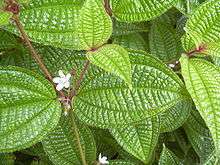Clidemia hirta
| Clidemia hirta | |
|---|---|
 | |
| Clidemia hirta | |
| Scientific classification | |
| Kingdom: | Plantae |
| (unranked): | Angiosperms |
| (unranked): | Eudicots |
| (unranked): | Rosids |
| Order: | Myrtales |
| Family: | Melastomataceae |
| Genus: | Clidemia |
| Species: | C. hirta |
| Binomial name | |
| Clidemia hirta (L.) D. Don | |
Clidemia hirta, commonly called soapbush or Koster's Curse, is a perennial shrub. It is an invasive plant species in many tropical regions of the world, creating serious damage.
Distribution
Originally from the American Neotropics (Mexico to Paraguay as well as the Caribbean),[1][2] it has been introduced to Australia, Southern Asia and East Africa.
It was introduced to Hawaii in the 1940s; by 1978 it had spread to over 90,000 acres (360 km2) of land on Oahu. In 1972 Koster's Curse was first spotted on the Big Island. In Sri Lanka it is quite invasive in wet zone and upcountry forests, especially invading gaps in the forest, preventing other native species from emerging.[3]
Biology
The plant grows 1–5 metres (3 ft 3 in–16 ft 5 in) tall, depending on habitat.
The black berries are up to 8 millimetres (0.31 in) long and taste a bit like a deeply flavored blueberry. Each fruit contains more than 100 tiny (0.5 mm) seeds. It flowers and fruits all year, if conditions are moist enough. A large plant can produce more than 500 fruits in a single year. The seeds are dispersed by birds, feral pigs, other animals, and humans. Sheep will not eat the plant, and the tannin inside the fruits is poisonous to goats. The seeds can remain viable in the soil for up to 4 years.
The human edibility factor of this berry has not been fully explored. The tannin inside of the fruit is not harmful to humans and a delicious syrup may be made from the fruit. The syrup has a beautiful indigo blue color and may be used to enhance and remove the bitterness of teas such as yerba mate.
Name
The epitheton hirta means "scrubby" in Latin. "Koster's curse" is a commonly used name in places where the plant grows as a noxious weed, such as Hawaii. Koster was the man who between 1880 and 1886 accidentally introduced seeds of C. hirta to Fiji in coffee nursery stock, where its problematic nature was first noticed around 1920 (Paine, 1934; Simmonds, 1937). Originally only known as "the curse" for the damage it did to coconut plantations, its vernacular name became a model after which those of other invasive plants were patterned, such as Ellington's Curse on Fiji, McConnel's curse in Australia, Curse of India in East Africa or Burbank's Folly in the Pacific Northwest.
Biological control
Koster's curse can form dense thickets that smother plantations, pastures and native vegetation.
Manually pulling plants out of the ground supplemented by herbicide application is an effective but temporary control method.[1] The thrips species Liothrips urichi from Trinidad is being used to biologically control C. hirta; it was first employed on Fiji in 1930 (Simmonds, 1933).
Introducing the plant to Australia can be fined with up to 60,000 (Australian) $.
Synonyms
Taxonomic synonyms for C. hirta include:
- Clidemia benthamiana
- Clidemia cognata
- Clidemia crenata
- Clidemia elegans
- Clidemia leptocada
- Clidemia pauciflora
- Dancera hirta
- Leandra fimbriata
- Melastoma anhaga
- Melastoma aristatum
- Melastoma elegans
- Melastoma rustica
- Staphidium elegans
- Staphidium hostmanii
References
- 1 2 "Clidemia hirta" (PDF). International Institute of Tropical Forestry. United States Department of Agriculture. Retrieved 2009-02-18.
- ↑ "Clidemia hirta". Germplasm Resources Information Network. United States Department of Agriculture. 1994-08-23. Retrieved 2009-02-18.
- ↑ Lalith Gunasekera, Invasive Plants: A guide to the identification of the most invasive plants of Sri Lanka, Colombo 2009, p. 95–96.
- Paine, R.W. (1934): The control of Koster's curse (Clidemia hirta) on Taveuni. Fiji Agricultural Journal 7(1): 10-21.
- Simmonds, H. W. (1933): Biological control of Clidemia hirta. Fiji Agricultural Journal, 6(2): 32–33.
- Simmonds, H. W. (1937): The biological control of the weed Clidemia hirta commonly known in Fiji as 'the curse'. Fiji Agricultural Journal, 8(3): 37–39.
External links
| Wikimedia Commons has media related to Clidemia hirta. |
- Images of C. hirta
- New World Fruits Database
- John K. Francis: Clidemia hirta (PDF file)
- Clidemia hirta information from the Hawaiian Ecosystems at Risk project (HEAR)